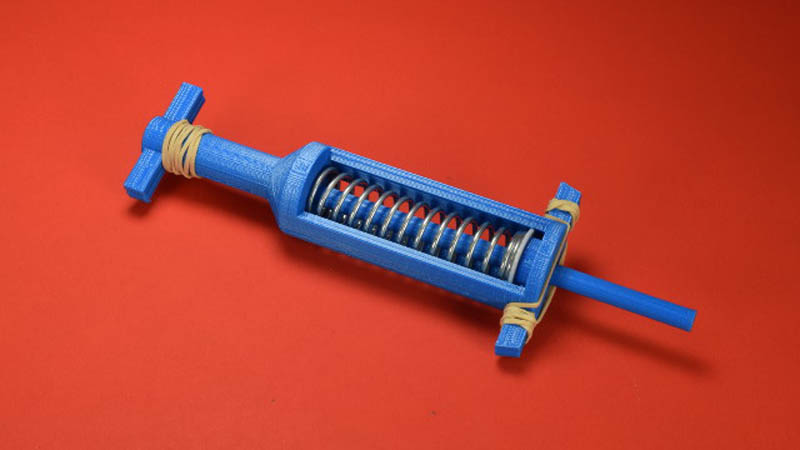Betteridge’s law of headlines states that any headline that ends in a question mark can be answered by the word ‘no’. It’s the case with articles asking if Millennials are responsible for all of the world’s ills, or if some technology is the future. So we come to this fascinating case of native content (amusing, veiled advertising) from a store that sells really, really powerful magnets. The title of the article asks if magnets can replace the spring in a pogo stick. The answer, of course, is no, but it does provide a fascinating look at linear versus exponential growth.
A pogo stick is simply a spring with a set of handles and footholds that is the subject of a great number of hilarious YouTube videos, at least one of which is impressive. The physics of a pogo stick is determined entirely by Hooke’s Law, and is a linear equation, not counting the strength of a spring and the yield point of steel, but this is a pogo stick we’re talking about. Magnets, on the other hand, obey the inverse square law. Is it possible to fit an exponential function to fit a linear function? No. No, it is not.

But a lack of understanding of the basic forces of nature never stopped anyone, so the folks at K & J Magnetics made a really neat test. They printed out a 1/8th scale pogo stick, complete with a spring. It worked like any pogo stick would. Then they took out the spring and put a few magnets where the spring should go. How did that work? Well, it bottomed out and was an immensely disappointing pogo stick.
If a problem is worth solving, it’s worth solving wrongly, so more magnets were added. Mounting three magnets onto a pogo stick gave the same exponential force, but still not enough. Four, five, and six magnets were added to the model pogo stick, and while six magnets gave this model pogo enough force to be ‘bouncy’, there simply wasn’t enough space for the pogo stick to compress.
The takeaway from this experiment is extremely obvious in retrospect, but probably too subtle for a lot of people. There’s a difference between a linear relationship and and exponential relationship. There’s also a video, you can check that out below.

















“Digital springs” however are a thing. A pogo stick that emulates a spring using electric motor should be possible. The benefits would be more craziness due to variable and adjustable characteristics.
Hmm, a Vetinari pogo stick…
Plink! Plink! Plink! squelch… Thwang!
But that needs power – and probably much power.
True, but today’s electric vehicles also seemed impossible a decade ago. Also there’s probably a lot of energy to recover from renegerative braking, so the net waste would be not that high.
Attempted solution: Place large magnet in moving portion. Place cylindrical magnet around moving portion. Taper cylindical magnet so that it is thinner at the top and thicker at the bottom.
Magnets would obey the inverse square if… there were magnetic monopoles. Besides, I don’t think “exponential” means what you think it means.
Got me thinking. Are permanent magnets really permanent? Does their repulsive “force” diminish with time?
Common sense says yes. How long one can expect to use 2 magnets like here before they wont repulse each other?
No, no more than gravity decreases with time. Well, technically, entropy will cause the ordered magnetic domains to eventually fall into chaos, but that’s on a hell of a time scale. But if you’re thinking there’s some kind of “energy” in magnets, that gets “used up”, and were then about to make the next step to perpetual motion machines via the idea that a fridge magnet can defy gravity seemingly for years without needing a power source, then… no.
Scientists aren’t fond of “common sense”.
Static forces do no work.
There is a little bit of potential energy in a magnet. You can extract it*, and then the magnet will need to be remagnetized.
*) For example, wrap a wire around it connected to a load. Heat the magnet above the curie temperature. When the field vanishes you will get a very small amount of power delivered to the load. The temperature will also very slightly increase.
In theory, yes. In practice…not necessarily. Magnetic “keepers” (you see them mostly on old horseshoe magnets) wouldn’t be necessary otherwise. If the magnets are stored alone, they should be fine indefinitely. However, if they’re stored in the presence of other magnetic fields, they can be degraded, depending on how strong those fields are.
As an example anecdote: I have four medium-sized (0.5″x2″), cylindrical neodymium magnets that have been doing little other than sticking to each other in a drawer for years. The very obviously have weaker and stronger points when rolled around each other, where they want to stick in specific positions, despite the fact that they’re axially magnetized and should roll freely.
As another example: The reason you shouldn’t take a stepper motor apart is because there’s a very good chance that you’ll get the “permanently” magnetized stator too close to the rotor. This causes some partial demagnetization of the stator, reducing the maximum torque the motor can produce.
How much of a magnetic field a permanent magnet can tolerate is dependent on the material it’s made out of. Specifically, if the coercivity of a magnet is low (such as in alnico magnets), its magnetic domains can easily be realigned/scrambled by an external field. If high (such as in neodymium), a much stronger field is required to do the same thing.
https://en.wikipedia.org/wiki/Magnet_keeper
High School Shop class told us,
Heat and Vibration are enemies of magnets.
You are touching on a concept about magnets called “hardness”. (not the same as the hardness of a stone with its 1-10 scale) Here hardness is a measure of how well a magnet keeps it’s magnetism. Interestingly all magnets used to decay fairly quickly given the state-of-the-art tech back then. Thermal agitation and such would eat away at the magnetic domains and randomize them until they were gone. Such magnets are known as “soft magnets” and that was all we had for some time. Later we figured out how to make stronger ones and along with that strength came a special bonus. The combined fields created by the domains within the magnet were actually able reinforce each other and keep each other stable making them “hard”er. As to whether the domains in that context self heal or even grow there, maybe someone at K&J Magnetics knows the answer. (Scientists like to apply the Ising model to describe this dynamic which is appropriate for the most part. :-) )
Magnets do impose fields upon each other so I suppose if the imposed fields are stronger than the hardness of the magnets, it could weaken them. Any one out there experience this?
Your shop teacher was right. That said there are a lot of different kind of magnets nowadays. Some have higher Currie points than others (the temperature at which a magnet looses its magnetism) Physical agitation as well as heat pound at the borders and potentially fragment magnetic domains within the magnet. If the magnet isn’t magnetically “hard” enough the damage could be substantial. I’ll admit I like my magnets too much to do much studying about what happens when you abuse them but there’s lots to know and learn there. I’m sure K&J Magnetics has a “wizard” there who knows a thing or two about that. Also, based on their numerous YouTube videos, they are not beyond abusing a magnet or two for the purpose of science. (or just plain amusement :-) )
Magnets no.
Electromagnets yes.
.” Magnets, on the other hand, obey the inverse square law. ”
Not so. Magnets are dipoles, which actually follow inverse CUBED law.
You are so right. (Unfortunately very few know that.) If the world knew just how much playing around with magnets and simulations of magnets I’ve done, they would consider putting me away until they realized I’m not doing anything dangerous. :-) It is true that at the force between magnetic mono-poles does respect the inverse square law, there effectively is no such thing as a lone magnetic mono-pole so if you are going to think about a North mono-pole you must also think about its mated South mono-pole and of course if you are going to talk about the forces between objects you will need another pair of mono-poles to interact with. So the absolute minimum number of points in any magnetic analysis is four mono-poles (two N and two S) If you double the distance between each pair, you do cut the forces between them by a quarter (assuming the distance between mated mono-poles is <<<<< the distance between magnetic pairs) but the cancelling effect from distant opposite mono-poles being further away also comes into play taking a k/(d^2) equation and more or less converting it to a k/(d^3) equation. Then there's the matter of bulk material with the vast number of inter-mono-pole interactions. This is *FAR* from simple and not at all analytical. Numerical methods and computers need to be used to add up total effects between, say two 1 cm cube magnets with parallel magnetic axis. The truth about magnets is an elusive and demanding harlot of a vixen, but *SO* very seductive, inciting you into trying all kinds of crazy things.
By the way, just to save some pain and suffering, Earnshaw's theorem is not only proven mathematically, it is also demonstrated in reality as well. Don't try to cheat it unless you like the idea of the vixen I just mentioned biting you. ????
(and using diamagnetic material is not cheating, you are just playing a different game outside the scope of Earnshaw's theorem)
It should come as no surprise that when you look at the I-Beam in my basement ceiling in my workshop, first you see the magnets, then the I-Beam because of the level of coverage. :-)
Uh… okay. I just learned along the way that magnetic field follow inverse cubed relationship rather than inverse squared.
I’ve got a simple solution. Get HUUGE Planet sized magnets. With those you’ll move through such a small portion of the field it will appear linear. Easy.
I’d like to point out the pogo stick was testing in a planet sized magnetic field.